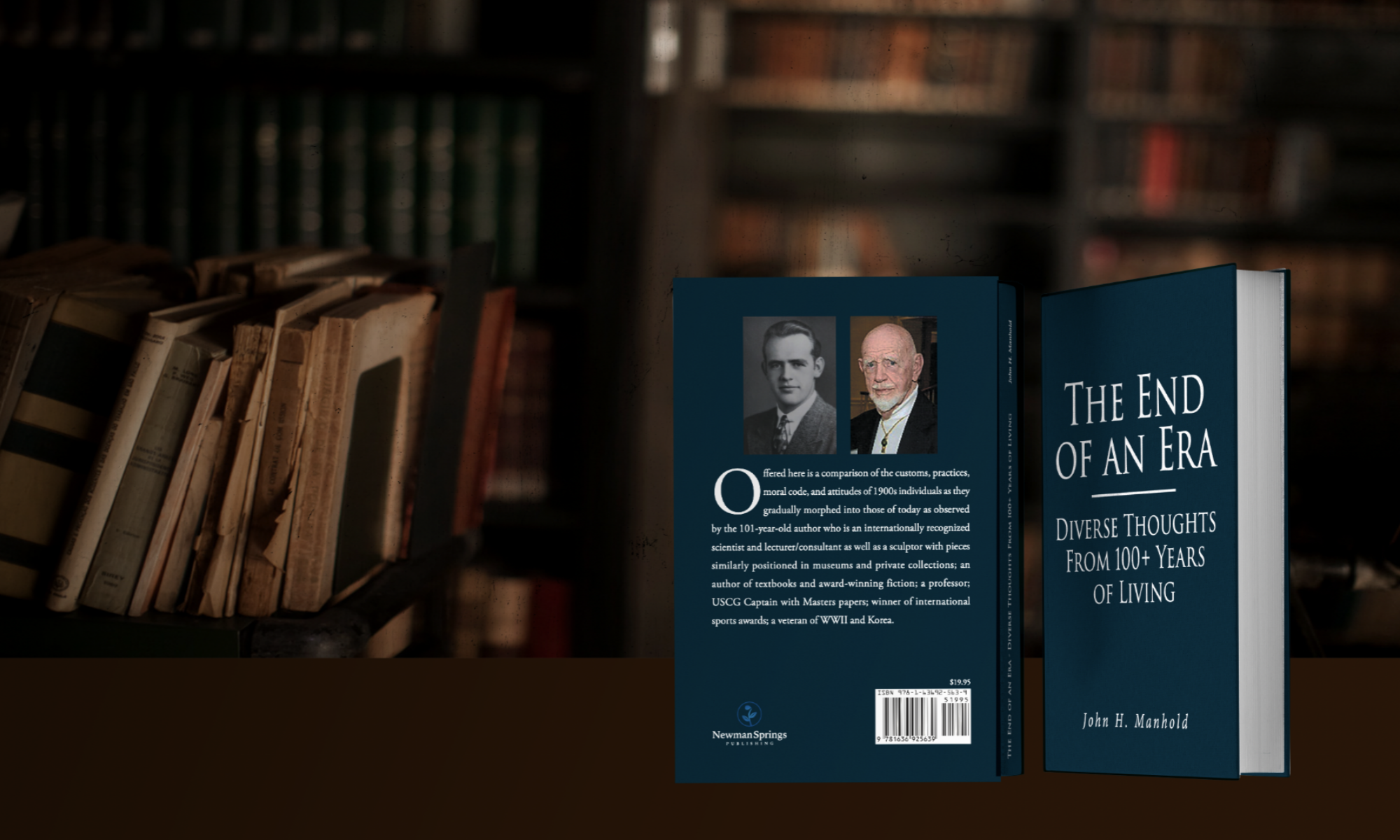The END of an ERA, Diverse Thoughts From 100+ years of LIving ISBN: 9781636925639 Newman Springs Publishing copyright and written by John H. Manhold.
For readers who regularly visit my website, I am sure this is something different than what you expected to find. Specifically I should like to alert you to the imminent publication of this author’s latest book, The End of an Era. Final print copy is scheduled to be released for distribution and sale in print (soft cover) by next week, followed by an e-book, and an audible version shortly thereafter.
Briefly, it presents comparative observations of various aspects of life as it began shortly after WW I and progressed through the multitudinous changes that evolved as the years crept by “in there petty pace from day to day” through the year 2020 and the early part of 2021. The century’s changes overall have been accumulating for millennia – only recently the rate of acceleration has changed to a pace even faster than during the Industrial Revolution. The past one hundred years has moved from a time when a man’s handshake was binding, and a resident of the then United States of America was free to indulge in, and could attain top-level accomplishments in any number of fields, to the present era where an amazing amount of control is occurring. In 1919 there was no TV, Jet flight, DNA, Cloning, computers, huge technological companies attempting to correlate and direct an individual’s thought pattern and direction. Even general ownership of radios did not exist (my father, an electrical engineer, built our first ‘Crystal Set’). But perhaps on an even more personal level. What has happened to empathy? How frequently do you encounter understanding of a problem? Instead, is your boss or other “uncaring” person too occupied to even listen to what you are saying? Or if the person listens, how much is he/she really hearing? The last study of attention span of humans I found was 8.1 seconds, which is comparable to that reported of a goldfish. Have you noticed how rapidly advertisements change on TV? How rapidly people speak these days? When answering the phone, you immediately are addressed by a recorded message? What has happened to loyalty? Whom do you really believe you personally can trust?
Dependence upon machines, computers, and artificial intelligence is our way of life. Its pace and the quantity of material required to be gathered and stored has grown far beyond existing capabilities. Regrettably, no choice exists but to continue while opening our lives to any and every one because no computer made to date is immune to hacking.
The 1919–2021 period of change has been of sufficient magnitude even to be equated with the now almost forgotten Renaissance, an era of total upheaval in the mores of society was occurring that escalated to almost unimagined levels in communication, transportation, housing, clothing, morals, matters of entertainment, patterns of thought—everything. Amusingly perhaps, also a time that has been compared with my unusual, highly varied life activities and often accompanied with suggestions—actual pressure—to publish them.
Until now, I have refused. Producing another exercise in self-serving egocentricity that few other than family and a few acquaintances might like to read always has seemed gauche until recently a young intern remarked that the opportunities I was offered no longer existed. I was fortunate in that my career developed during a period when investigative opportunities were numerous and ability to meet and exchange ideas with notable people easily occurred. The conversation began an introspective progression of thoughts that led to my reconsideration and although I have not acquired any status as a celebrated professional athlete, revered statesman, honored warrior, or even received extensive media coverage as a celebrated stage or cinematic performer, I have gained a certain level of recognition in several areas that have provided me with an opportunity for worldwide travel and intimate time spent with people of many different cultures. Thus evolved the intention here to describe my serendipitous journey in an obvious and/or easily verifiable manner, and as it occurred with observations on the era differences and an intent to offer impressions gained through these years spent with many people of different, or possibly similar but somehow “different” mores as they change with time. Also, I should like to impart some of the insight (?) gained that could offer takeaway thoughts for others.
Generally speaking, there is little interest in the past. Few read history with the lessons that it teaches, and even historical novels are passé. This book sets forth a contrasting picture between the 1900s and the present century. It is one man’s story by a man who has lived through those 100+ years and set forth in his words as the events are remembered and written with obvious and/or referenced substantiation. You might discover features and/or circumstances that elicit personal thought(s).
John H. Manhold
